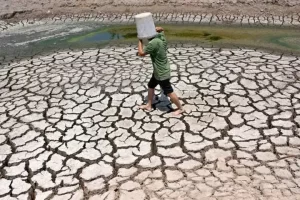Table of Contents
Every day, Vietnam farmer Nguyen Hoai Thuong hopes in vain for rain to moisten the cracked, parched soil of her garden in Vietnam’s Mekong Delta, the country’s agricultural heartland known as the “rice bowl.”


A scorching month-long heatwave has brought drought, leaving the land in Thuong’s hometown of Ben Tre province, 130 kilometers (80 miles) south of the business hub Ho Chi Minh City, arid and cracked.

Join our Telegram Channel for Updates
Despite being crisscrossed by waterways, the prolonged heatwave and absence of rainfall are causing salinization, and the intrusion of saltwater from the sea, severely affecting crops in a region crucial for feeding the nation of 90 million people.
“It’s disheartening to leave the rice field barren like this because we lack fresh water. I have to switch to raising cows instead,” lamented 31-year-old farmer Thuong to AFP from her sweltering village, where what should be lush rice paddies now lie cracked and dry.
Without rain, her family has no access to fresh water for even basic domestic needs, and last month, she had to purchase some from her neighbor for 500,000 dong ($20). The once verdant rice paddies in southern Vietnam now stand desiccated and cracked amidst the relentless heatwave.
“We lack a fresh underground water source to use while the surface water is saline,” she explained as her father pumped water from a mobile container into the family’s 1,000-liter storage tank. The water Thuong purchased is strictly for household use—from drinking and cooking to bathing—and cannot be used for crops.
The Mekong Delta encounters saltwater intrusion annually, but more intense hot weather and rising sea levels—both driven by climate change—are heightening the risk.
Meteorologists indicate that the delta is experiencing an unusually prolonged heatwave this year, leading to drought in several areas, diminished water levels in canals, and saltwater intrusion—and they caution that the worst may still be ahead.
Saltwater levels are typically higher during the dry season, but they are exacerbating due to rising sea levels, droughts, tidal fluctuations, and a scarcity of upstream freshwater. A recent study revealed that the delta, which sustains food and livelihoods for tens of millions of people, faces nearly $3 billion in crop losses annually as saltwater infiltrates arable land.
Approximately 80,000 hectares of rice and fruit farms could be affected by salinization, according to the research conducted by the Water Resources Science Institute under the Environment Ministry.
Ben Tre province, where Thuong’s village is situated, suffered approximately $472 million in losses each year from 2020 to 2023, as per the study. “I had to reduce my cultivation from three to only two rice crops each year. All the water in my area has become too salty to use for anything,” shared farmer Phan Thanh Trung from one of his fields.
His neighbor Nguyen Van Hung, however, is more fortunate—he has a plentiful underground supply of fresh water that he can profit from. “During times of drought and saline intrusion, I sell my fresh water to my neighbors. But truthfully, I’m not happy,” remarked Hung. “Adverse weather patterns have truly taken a toll on us.”









